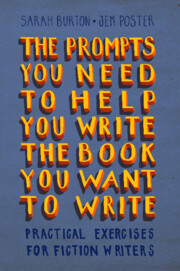Refine search
Actions for selected content:
166 results
Chapter 2 - Comedic Characterization in the Euthydemus
-
- Book:
- Plato on Comedy and Tragedy
- Published online:
- 24 October 2025
- Print publication:
- 13 November 2025, pp 54-87
-
- Chapter
- Export citation
2 - Character
-
- Book:
- The Prompts You Need to Help You Write the Book You Want to Write
- Published online:
- 25 October 2025
- Print publication:
- 06 November 2025, pp 15-28
-
- Chapter
- Export citation
4 - Dialogue
-
- Book:
- The Prompts You Need to Help You Write the Book You Want to Write
- Published online:
- 25 October 2025
- Print publication:
- 06 November 2025, pp 47-63
-
- Chapter
- Export citation
Chapter 2 - The Case against the Virtue Approach
-
- Book:
- Moral Heroism without Virtue
- Published online:
- 23 October 2025
- Print publication:
- 06 November 2025, pp 30-60
-
- Chapter
- Export citation
9 - Description
-
- Book:
- The Prompts You Need to Help You Write the Book You Want to Write
- Published online:
- 25 October 2025
- Print publication:
- 06 November 2025, pp 108-123
-
- Chapter
- Export citation
12 - Summary, Legacy, and Relevance
-
- Book:
- Before the Fed
- Published online:
- 16 October 2025
- Print publication:
- 30 October 2025, pp 187-204
-
- Chapter
- Export citation

The Prompts You Need to Help You Write the Book You Want to Write
- Practical Exercises for Fiction Writers
-
- Published online:
- 25 October 2025
- Print publication:
- 06 November 2025
Chapter 7 - Kant’s Metaphors and Analogies
- from Part I - Linguistic Implications of Kant’s Thought
-
-
- Book:
- Kant on Language
- Published online:
- 19 September 2025
- Print publication:
- 09 October 2025, pp 120-136
-
- Chapter
- Export citation
Chapter 9 - The Legal Character of Paupers in Early Nineteenth-Century England
-
-
- Book:
- British Law and Literature in the Long Eighteenth Century
- Published online:
- 19 September 2025
- Print publication:
- 09 October 2025, pp 187-208
-
- Chapter
- Export citation
Chapter 1 - The Personified Will
-
- Book:
- The Will in English Renaissance Drama
- Published online:
- 04 September 2025
- Print publication:
- 18 September 2025, pp 32-62
-
- Chapter
- Export citation
Introduction
-
- Book:
- Face and Form
- Published online:
- 21 August 2025
- Print publication:
- 04 September 2025, pp 1-21
-
- Chapter
-
- You have access
- Open access
- HTML
- Export citation
Chapter 2 - The Elements of Moral Character
- from Part I - Introductory
-
- Book:
- Attention to Virtues
- Published online:
- 25 July 2025
- Print publication:
- 14 August 2025, pp 26-36
-
- Chapter
- Export citation
Enemies
-
- Journal:
- Journal of the American Philosophical Association / Volume 11 / Issue 4 / December 2025
- Published online by Cambridge University Press:
- 11 August 2025, pp. 659-676
-
- Article
-
- You have access
- Open access
- HTML
- Export citation

Writing the Detectives
- Character and the Series Form
-
- Published online:
- 28 July 2025
- Print publication:
- 21 August 2025
-
- Element
- Export citation
Introduction
-
- Book:
- Neil MacCormick
- Published online:
- 22 May 2025
- Print publication:
- 12 June 2025, pp 1-17
-
- Chapter
- Export citation
Epilogue
-
- Book:
- Neil MacCormick
- Published online:
- 22 May 2025
- Print publication:
- 12 June 2025, pp 566-569
-
- Chapter
- Export citation
Chapter 4 - Nationalism: Character, Identity, and Hyphenated Selfhood
- from Part I - Concepts
-
-
- Book:
- The Cambridge Companion to Nineteenth-Century American Literature and Politics
- Published online:
- 06 March 2025
- Print publication:
- 13 March 2025, pp 67-92
-
- Chapter
- Export citation
Introduction
-
-
- Book:
- The Cambridge Companion to Biblical Narrative
- Published online:
- 30 January 2025
- Print publication:
- 06 February 2025, pp 1-11
-
- Chapter
- Export citation
III - The Historian’s Character
-
- Book:
- Authority and Tradition in Ancient Historiography
- Published online:
- 31 January 2025
- Print publication:
- 06 February 2025, pp 128-174
-
- Chapter
- Export citation

The Cambridge Companion to Biblical Narrative
-
- Published online:
- 30 January 2025
- Print publication:
- 06 February 2025
